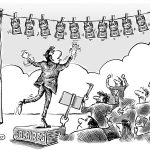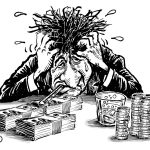The Return of Dr. Doom
At 93, Henry Kaufman gives his thoughts on the evolution of finance and monetary policies… A lesson to ponder.
Henry Kaufman represents for many in the profession, the model of the “Fed Watcher”. At the head of the research department of Solomon Brothers Bank for more than 20 years, he practically invented the profession.
I have been fortunate enough to meet with and listen to the man that the markets had long emblazoned with the title of Dr. Doom. In the fifth book he has just published1, Henry looks back on a particular event: the day he changed his point of view, considering that bond yields – like the Federal Reserve’s key rates – would now fall. That was August 17, 1982. Although he was not the only one, or even the first to think so, his “memo” had a particular impact on the markets. Perhaps because the time had finally come to hear this message? Perhaps also because the person who delivered it had defied consensus for so long by maintaining the opposite view for many years. A lesson in rigorous analysis and constancy whose power should be appraised.
In my view, these briefs hold the value that is given to examining long-term market trends. Indeed, the US (and European) bond yields have been falling for almost 40 years, albeit with the occasional jolt, but never reversed. We are still exploring the reasons for this long term descent. From a market perspective, the Federal Reserve, under Paul Volker, launched the battle against inflation in 1979. The following years were marked by the financialization of the economy, deregulation, internationalization and computerization of the financial sector.
Far from mastering the system, the Central Bank now seems to be trapped in it, and launched into a headlong rush.
But for the author, and the ever-relevant analyst of our system, this tremendous expansion has also been accompanied by an increasing concentration of the financial sector, and therefore of the ever larger and more complex portfolios of assets themselves. However, concentration means a loss of fluidity and an increased risk on liquidity, a quality whose absence is unfortunately more often measured. The subprime crisis has provided a stark demonstration of this. Furthermore, the great recession has only amplified the trend towards concentration of the financial system, with the financial system and banks morphing into “public utilities”, which certainly generate profits when everything is going well, but which the Central Bank cannot allow to fail any longer. The Federal Reserve could only dig this furrow, faced with the repo crisis in the fall of 2019, then again with the pandemic crisis in 2020. Worse still, the Central Bank in charge of banking supervision has become both judge and jury: not necessarily dissatisfied with having only a small – but systemic – number of institutions to monitor and regulate, but not able to arbitrage or let some fail when necessary.
Far from mastering the system, the Central Bank now seems to be trapped in it, and launched into a headlong rush. The same is true of its monetary policy, which is forced to relax its inflation targets because it is unable to achieve them. Having become a lender of prime resort for the financial system, it has also rescued other non financial corporations. And yet, the slow decline in the general quality of assets continues. The inexorable decline in yields and the floor level of policy rates encourage companies themselves to choose debt rather than profitability. The widespread downgrading of non-financial corporate ratings does not seem to scare anyone. The ever-smaller number of AA ratings or more, the rise in ratings in BBB or less, is hardly alarming. Since no one will be allowed to go bankrupt, what is the point of worrying about it? On the contrary, we can buy back shares, allow prices to rise, satisfy shareholders and savers. A smokescreen in the face of the erosion of profitability?
Thus, the cyclical downturn is no longer the time for the balance sheet cleansing, the improvement of profitability, the resumption of investment, the strengthening of competition thanks to the arrival of new entrants. What matters is the capacity that one can further extend its leverage. Minds are ready for it and are wondering – as much as actually yearning for – what more central banks can do! That is, when will they take off in their monetary ‘helicopter’?
To date, the major central banks, embracing too many missions, with bloated balance sheets, have lost their independence. By compromising their credibility in terms of inflation, do they not put themselves in a little more danger of losing credibility, and therefore of effectiveness?
If that were indeed the case, we would be on the verge of closing the long chapter opened in the early 80s. Who will report it to us, and above all who will be able to hear it?
1 Henry Kaufman, «The day the markets roared» BenBella Books Inc 2021
Valérie Plagnol – May2021 – Published in French in www.allnews.ch – Cartoon ©Barret



